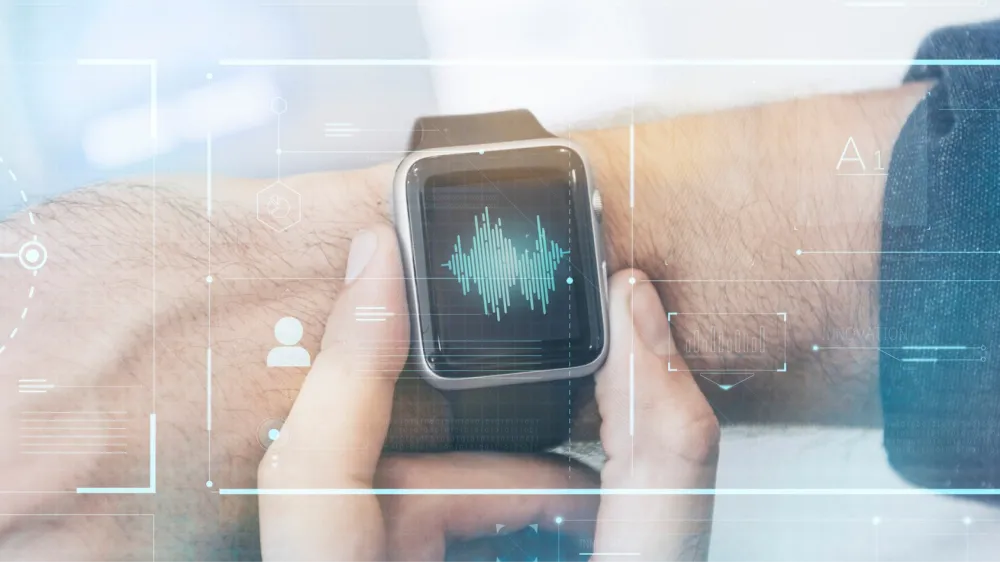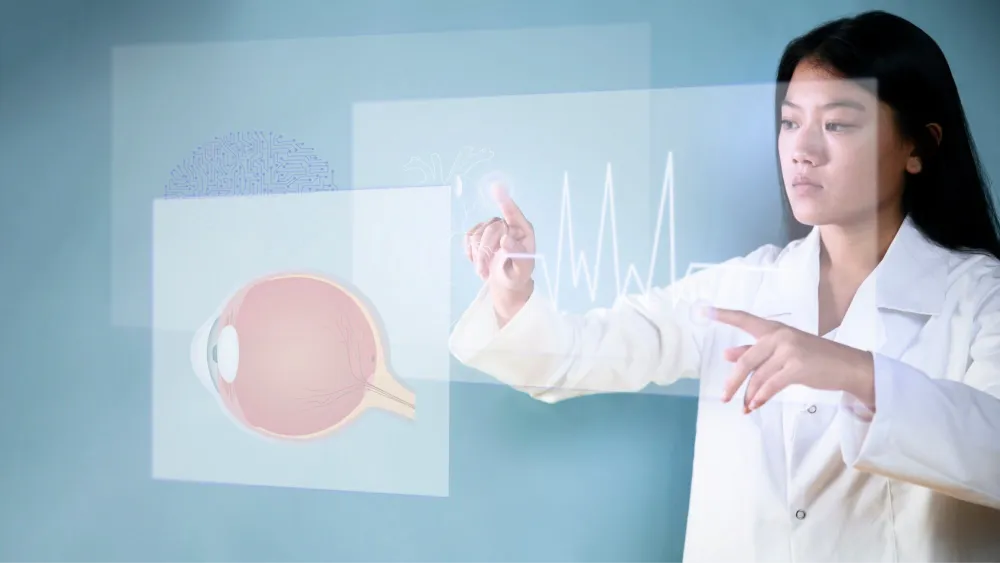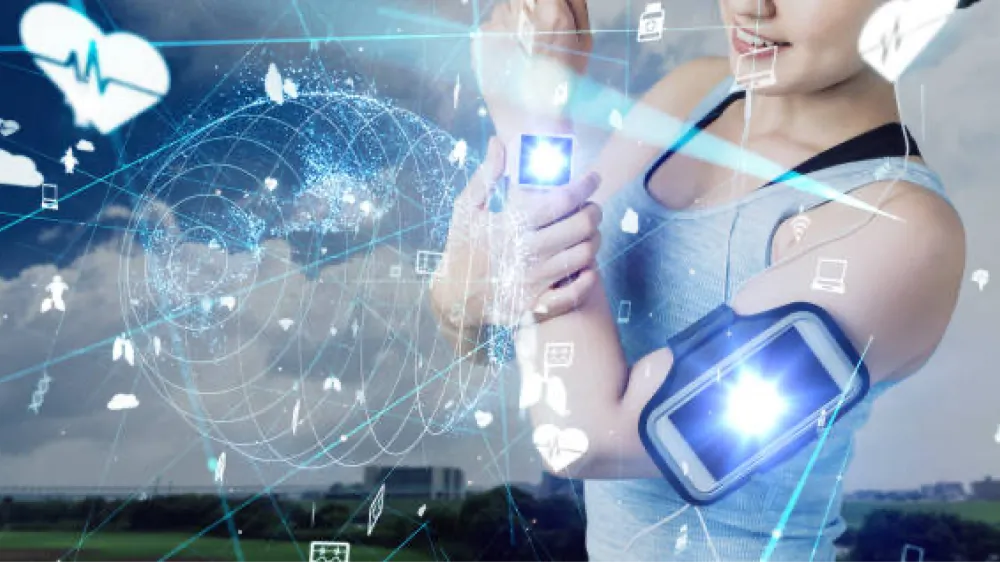The digital revolution has now reached our bodies. With wearable technology in healthcare revenue projected to hit $69.2 billion by 2028, there’s no doubt that this new technology is the next frontier for personalized healthcare.
The wearable industry holds great promise, with leading IT companies rushing to secure users for their wearable technology innovations. Tech giants like Microsoft, Apple, and Samsung have all entered the game with several product launches in recent years.
This article will explore the benefits and challenges of wearable technology in healthcare to get you up to speed with this emergent tech.
What is Wearable Technology in Healthcare?
Wearable technology in healthcare refers to devices attached to bodies that gather patients’ health-related data for doctors, physicians, insurers, and other parties to analyze and research.

These devices, such as smartwatches, fitness trackers, blood pressure monitors, biosensors, electrocardiogram (ECG) monitors, and glucose meters, are commonly used in remote patient monitoring and telehealth services. The common theme is that they track and monitor vital signs such as heart rate, glucose levels, and blood pressure.
The Importance of Wearable Health Monitoring Devices
Wearable technology is no longer limited to step trackers or blood pressure monitors, though. It has evolved to become a powerful tool in the healthcare system, empowering patients by enabling them to take control of their health through comprehensive health monitoring, preventive healthcare facilitation, and proactive personal healthcare.
Wearable technology empowers healthcare to keep an eye on health metrics continuously. This is especially important for chronic diseases when every subtle variation can signal disease exacerbation. With integrated health sensors, these devices allow for fully remote observation and swift medical interventions.
Traditional periodical check-ups often rely on information relayed from patients, families, or spouses, which can lead to inaccuracies in diagnosis. However, by consistently recording vital signs and maintaining detailed observations, healthcare providers can leverage objective, data-driven indicators to make more accurate medical decisions.
In preventive healthcare, wearable technology offers an unprecedented advantage by using historical data, user behavior, and medical records as guides. Through real-time data recording, medical professionals can track a patient’s health status, anticipate potential issues, and intervene before conditions worsen.
Integrating Wearable Technology with IoMT Solutions
Wearable technology in healthcare is instrumental in gathering real-time health data and transmitting it over the Internet of Medical Things. Healthcare professionals get access to this shared data system to collect statistics for further analysis and research. This seamless exchange facilitates proactive health monitoring, early detection of potential health issues, and personalized healthcare plans, enhancing patient care and outcomes.
What is IoMT?
The Internet of Medical Things (IoMT) is the network of Internet-connected medical devices, hardware infrastructure, and software applications that connect healthcare information technology. It encompasses wireless and remote devices that securely communicate over the Internet to allow rapid and flexible medical data analysis.
How To Integrate Wearable Technology With IoMT Solutions?
The process of integrating medical technology with IoMT solutions involves several key steps, including robust cybersecurity measures to protect sensitive health information. This ensures that your health data is secure, giving patients the confidence to embrace wearable technology in healthcare.

The next step is adopting advanced analytics and AI algorithms to extract actionable insights and identify trends that can inform patient care plans. Healthcare professionals receive processed data, enabling them to monitor patient health remotely, adjust treatments, and provide personalized care.
Finally, patients can access their data through user-friendly interfaces, which foster a collaborative approach to healthcare, where patients and providers work together toward common health goals.
To rapidly integrate wearable technology with your IoMT solutions and clear any development backlogs, consider our Backlog Acceleration Service.

Benefits of Wearable Technology in Healthcare
Wearable technology in healthcare is spearheading a revolutionary transition, significantly altering our approach to efficient medical care and ushering in a new era of proactive health management. Some of the benefits of wearable technology in healthcare include:
- Enhance real-time health monitoring
- Increase access to healthcare data
- Detect potential health issues early
- Support for chronic disease management
- Personalize healthcare plans
- Reduce healthcare costs

1. Enhance Real-Time Health Monitoring
Wearable devices are valuable tools that continuously track patients’ biometrics to spot whether they are sick or healthy. For instance, wearable devices can alert healthcare professionals and patients to irregular vital signs indicating an impending critical situation, such as a heart attack or severe allergic reaction. This capability ensures immediate response, saving lives by allowing for rapid deployment of emergency services or medication adjustments.
2. Increase Access to Healthcare Data
Thanks to innovative wearable technology, vast amounts of healthcare data are becoming accessible. Automated collection of detailed health metrics eliminates the need for time-consuming physical research and surveys. Such easy access to data pools offers invaluable insights for healthcare professionals, enabling more efficient analysis of health trends and patients’ needs.
3. Detect Potential Health Issues Early
By monitoring subtle changes in vital signs, these devices allow healthcare providers to predict and address possible health concerns before they evolve into more severe conditions. With early detection of initial health symptoms, they are prepared for potential circumstances and can suggest viable solutions, saving lives and reducing unnecessary complex treatments.
4. Support for Chronic Disease Management
For individual chronic disease management, this technology is helpful in remote monitoring, informing a patient’s care team about the efficacy of a given treatment plan. It also facilitates frequent updates on the diagnosis of their chronic disease without periodical physical health check-ups. A continuous stream of personalized data also supports the creation of customized healthcare plans and control of individual variations in vital signs, optimizing the treatment for each patient’s unique needs.
5. Personalize Healthcare Plans
Personalized health coaching has become a reality as healthcare wearables support telehealth services and remote patient monitoring. Healthcare providers can tailor treatments and preventive measures based on the continuous flow of data from wearables, allowing for immediate adjustments in response to sudden changes in vital signs.
6. Reduce Healthcare Costs
Modern wearable technology devices also improve health outcomes while lowering the cost of treatment. Data can be collected and reported digitally, eliminating geographical constraints and traveling inconveniences from in-person appointments. This enhances the quality of patients while lessening hospital visits and lower healthcare expenses.
Challenges of Wearable Technology in Healthcare
Pushing the boundaries of innovation while addressing data privacy concerns and successful integration is a balancing act. To leverage the full potential of wearable technology in healthcare, pay attention to the following issues:
- Data privacy concerns
- Accuracy and reliability issues
- High cost
- Integration challenges

1. Data Privacy Concerns
One of the primary issues revolves around data privacy. Who owns this vast amount of data, how it is utilized, and how it is secured remain tricky questions to solve. At the core of the development of wearable technology is balancing the utility of data collection, safeguarding against breaches, ransomware, or other unauthorized access, and implementing data loss prevention in healthcare.
The sensitivity of health-related data necessitates strict cybersecurity measures to ensure patient data are kept confidential at all times. Partnering with data-driven technology solutions providers such as KMS Healthcare helps companies launch faultless products and consistent maintenance services — securing data against sophisticated malicious attacks.
2. Accuracy and Reliability Issues
Wearable devices gather data in aggregate form but face constraints when analyzing it for conclusions. As these devices mainly apply one-size-fits-all algorithms, healthcare professionals are raising concerns about their reliability in specific patient cases.
Any inaccuracies in the hardware and software of wearable technology will impact the effectiveness and credibility of wearable devices. Even with advancements in physiological sensors, there remains a risk of inaccurate or misleading data, which could compromise patient care and outcomes. Solutions can be found in constant improvement for wearable healthcare technological devices and data double-checking once collected.
3. High Cost
Another significant hurdle for the widespread adoption of wearable technology in healthcare is its high cost. Hefty price tags can place wearable tech beyond the average consumer’s reach, which augments hesitation to conform to any health management approach.
These devices often incorporate advanced technologies, such as sensors for real-time health monitoring and wireless connectivity for data transmission, which contributes to their price. The industry can shorten the gap by investing in cost-effective materials and efficient production methods.
4. Integration Challenges
Incorporating wearable technology into existing systems requires a seamless flow of data and interoperability among different software applications. Ensuring that devices from other manufacturers can communicate effectively is often tricky.
Healthcare providers must adapt their practices to incorporate data from wearable technologies into patient care routines effectively—training staff and managing the influx of data to enhance decision-making processes in healthcare.
Top 5 Examples of Wearable Technology in Healthcare
Due to the growing diversity of health problems, various medical devices and multiple renovated versions have been invented. Here are the five notable examples of wearable technology in healthcare:
- Blood pressure monitor
- Glucose monitoring device
- Wearable ECG monitor
- Fitness tracker
- Integrated activewear

1. Blood Pressure Monitor
A blood pressure monitor consists of a cuff that is placed around the upper arm and a digital display that provides real-time readings of systolic and diastolic blood pressure. A&D Medical’s Essential Manual Inflate Blood Pressure Monitor, for example, can help track changes in blood pressure over time at home or on the go and provide valuable data for healthcare professionals.
2. Glucose Monitoring Device
Glucose monitoring device estimates what your glucose level is every few minutes and keeps track of it over time. Devices like the Abbott Freestyle Libre 2 are placed on the upper arm, and a phone sensor is used to measure the reading. It includes real-time glucose alarms that help make informed decisions about consumption of the food and beverages.
3. Wearable ECG Monitor
A wearable ECG monitor comprises an ECG sensor and an accelerometer for capturing and logging physiological data. ECG patches are interconnected with devices like smartphones or tablets for display. ECG monitors are available on the Apple Watch or as standalone devices like KardiaMobile. Modern ECG monitors not only efficiently measure electrocardiograms but also detect if any abnormalities occur. Patients can then share the data with physicians for further analysis and diagnosis.
4. Fitness Tracker
Fitness trackers provide real-time feedback and analysis of physical activities such as heart rate, calorie consumption, and sleep patterns. It is worn on the wrist and uses sensors to collect data, allowing users to monitor their progress toward fitness goals and adjust their lifestyle. Wearable fitness trackers are integrated with smartphone applications with advanced features such as GPS tracking and waterproofing for more comprehensive health monitoring.
5. Integrated Activewear
Integrated activewear integrates microscopic sensors into apparel or footwear to safeguard the wearer’s body or assist them in reaching their fitness objectives, such as Ralph Lauren’s sensory bright shirt. Posture apparel with sensors prompts people to assume the proper lifting position and practice precise movements. Airbag hip protectors activate when sensors detect a fall.
Future Trends and Innovations
Current market trends mostly center on the new product generations’ underlying technology breakthroughs. These include adding new health features, incorporating AI to make individualized suggestions, and sending real-time data to healthcare practitioners so they can respond quickly and enhance patient outcomes.

Beyond wearable technology in healthcare, there has been a sharp increase in the creation of healthcare applications and renovated versions. The healthcare industry is increasingly integrating wearable devices into these applications, along with the invention of emerging technologies like augmented reality, machine learning, the blockchain, etc.
In short, 2024 is poised to be a pivotal year for wearable tech, with Apple and Garmin continuing to be the market leader in producing wearables with innovative health-related features. However, as disruptors like Asus, Motorola, and Swatch have also entered the market with noticeable innovations, it’s clear that wearable technology in the healthcare sector has plenty of room for growth.
FAQs
Can wearable devices help in emergencies?
In scenarios requiring immediate medical attention, such as heart attacks or falls, wearable devices can automatically alert healthcare providers or emergency services. Additionally, wearables equipped with GPS technology can pinpoint the wearer’s exact location, facilitating faster and more accurate emergency responses.
For patients with chronic conditions, wearable devices can monitor worsening health and alert the user and their healthcare providers before the situation escalates into an emergency.
Can wearable devices aid in managing large patient groups?
Wearables enable remote monitoring of patients, allowing healthcare providers to keep track of many patients simultaneously without requiring them to be physically present in healthcare facilities. This is particularly beneficial for managing diseases like diabetes or hypertension, where continuous monitoring is essential.
Healthcare professionals can utilize algorithms and AI tools to analyze the vast amounts of data generated by wearable technology to identify trends, predict risks, and provide high-quality care to more significant population segments with reduced physical infrastructure and resource allocation.
How can data from wearable devices be integrated securely into existing systems?
Wearable devices must navigate complex regulatory landscapes. Before being integrated into existing systems, they must comply with healthcare regulations and standards to ensure the safety and privacy of PHI.
In addition, healthcare providers should adopt robust encryption methods during data transmission and storage. Implementing strict access controls and regular security audits can safeguard patient data.
Let KMS Healthcare Do The Heavy-Lifting For You
Companies like yours are looking to meet the growing demand for healthcare wearable technology. More widespread acceptance by consumers and healthcare providers may come slowly with barriers like doctor skepticism, data privacy, etc., in the way.
Unleash your potential by working with a reliable technology partner to guide you through all these challenges. KMS Healthcare is your full-service solution, with a team comprised of platform-certified developers experienced in researching, testing, integration, and delivery. Contact KMS to learn more.
